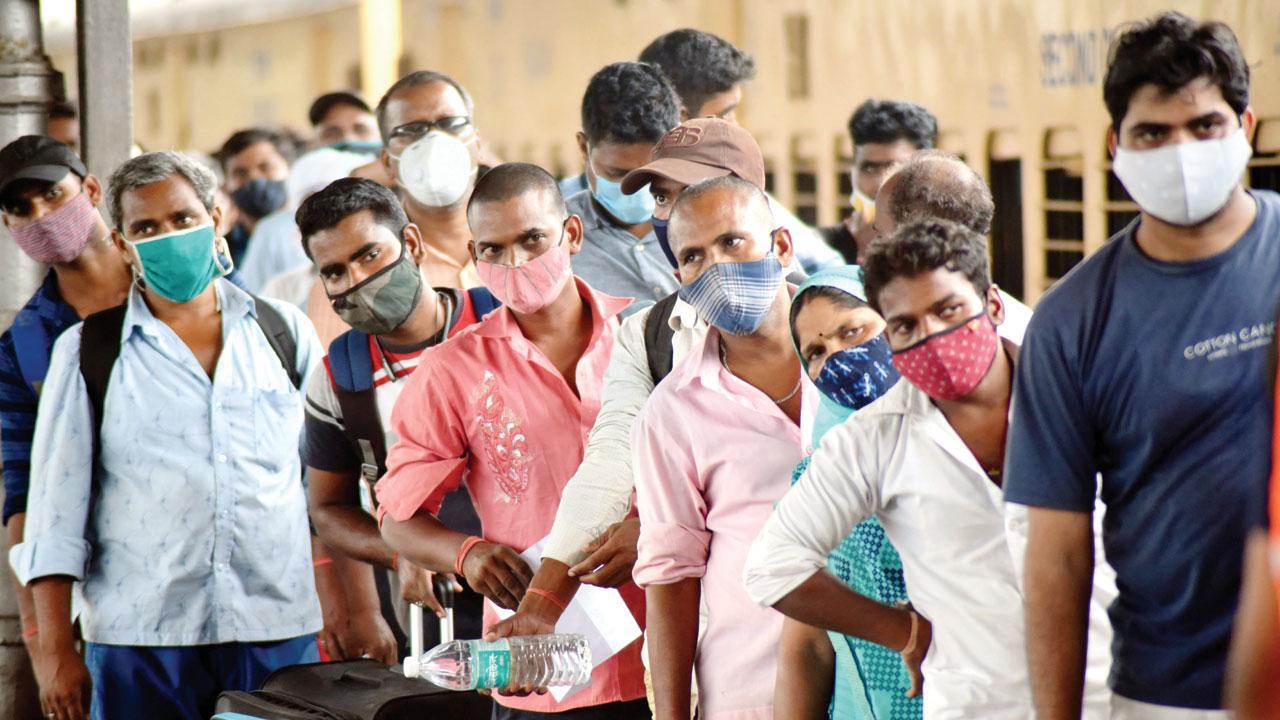Lowered antibodies of slum residents and returning workers put the areas at risk ahead of a likely third wave

Civic officials say migrant workers who went home due to the lockdown will return in large numbers. Pic/Sameer Markande
Faced with the threat of a third Covid-19 wave, decreased antibodies among the slum population and expected inflow of migrant workers, the BMC is gearing up for tracing, testing, tracking and treatment. It has planned to deploy mobile testing vans, increase antigen testing and open more quarantine centres to deal with the potential new wave. Officials say they are again roping in private practitioners, as the past two waves have showed that people with symptoms consult their family doctors and hesitate to go to civic-run facilities.
ADVERTISEMENT
A beneficiary receives an anti-Covid-19 shot at a vaccination centre in Dharavi. File Pic/Ashish Raje
Besies the proven formula of tracing, testing, tracking and treatment, vaccination will be a major weapon against the third wave, says civic officials.
The civic body said that the fear of rapid spread of infection in the densely populated slums in the city, which happened during the first wave, is back. Though during the second wave, cases remain mostly concentrated in high-rises, experts have warned that Covid-19 would take a U-turn in the third wave and put slum dwellers at risk.
The three serosurveys conducted at intervals over the past one year have particularly raised the concern, as the results showed that antibodies among the slum residents have gradually reduced and increased among the population in the non-slum areas.
Also Read: Covid-19: Slum dwellers in Mumbai at risk, again, in third wave
According to the third survey conducted in March this year, 41.6 per cent seropositivity was found in the blood samples taken from municipal hospitals (slum areas). It was 57 per cent in the first survey (July 2020) and reduced to 45 per cent in the second (August 2020).
“Decreasing number of antibodies is one reason. The other reason is expected inflow of people, who went to their hometown after the lockdown during the second wave, in large numbers. This population stays in close vicinity of each other, has little space at home, and uses public facilities,” said additional municipal commissioner Suresh Kakani.
Residents line up for Shiv Bhoaj meal, at St. Kakayya Road, Dharavi. File Pic/Suresh Karkera
“The four T formula — tracing, testing, tracking and treatment — worked well in Dharavi and we will stick to it. In addition, we now have mobile testing vans and antigen tests that give results in a short time. So tracing and testing will be key this time,” said Kiran Dighavkar, assistant commissioner of G north ward, comprising Dharavi, Mahim and Dadar.
Kakani said, “Our basic mechanism will remain unchanged. From the experience of the past two Covid-19 waves, we know that people go to their family doctors (private practitioners) and hesitate to come to civic-run facilities after they develop symptoms. The SOP for treatment should be identical and that’s what we are communicating to general practitioners.”
He added that the quarantine centres are on standby and will be opened as and when required.
Dr Jitendra Jadhav, health officer of L ward where 80 per cent of population lives in slums, said, “We are not only focusing on slums, but the entire ward. We have started creating awareness and sensitisation through health posts and are putting an emphasis on vaccination, as it is the major weapon against the pandemic.”
The municipal corporation is also focusing on home visits in slums, as instructed by the civic chief in a latest meeting.
 Subscribe today by clicking the link and stay updated with the latest news!" Click here!
Subscribe today by clicking the link and stay updated with the latest news!" Click here!






